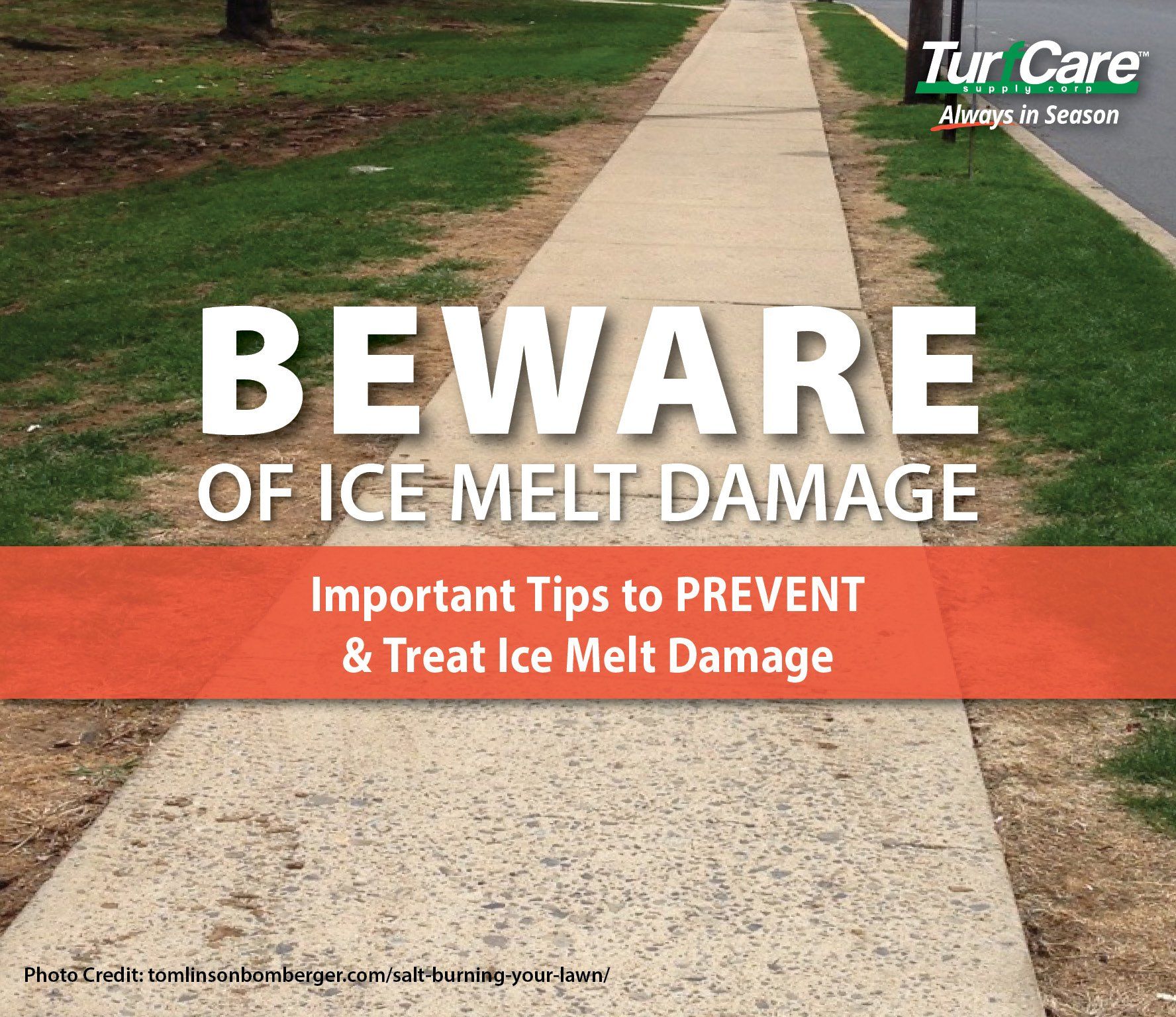BEWARE of Ice Melt Damage

IMPORTANT TIPS TO PREVENT & TREAT ICE MELT DAMAGE
Applying Ice Melt to walkways and drives is a necessary and effective way to prevent slips and falls throughout the winter season but it can also cause adverse effects to lawns and landscapes. Following these steps can assist with the prevention and treatment of ice melt damage:
IDENTIFYING ICE MELT THREATS
Ice melt damage occurs when turf and ornamentals become burned by splashed product or when it is dissolved into water runoff and absorbed into the root system. Damaged areas are often located next to the street, sidewalk or driveway where ice melt has been applied regularly throughout the winter season. Continued splashing of ice melt onto turf or ornamentals can increase salt concentration to a toxic level that will result in weaken or dying plants.
- NOTE: Some grasses, foliage and ornamentals exhibit a higher tolerance to ice melt while others, like, shallow-rooted species and evergreens, can be injured very easily. Be sure to protect the weaker plants or do not plant them near areas where ice melt will be applied. Call your state extension office for a listing of resistant species in your area. Ice melt damage may not be detected until spring when plants begin to green-up and grow again.
WAYS TO IDENTIFY ICE MELT DAMAGE/SALT TOXICITY IN TURF AND ORNAMENTALS:
- Plants are delayed in leaf bud breaking and flowering
- The foliage and buds are stunted
- Tips of plants are brown
- Shoot growth is reduced
- Crown thinning and tufting at branch tips
- Foliage prematurely changes colors or losses leaves
- Twig mortality
- In severe cases, invasions by insect borers, crown dieback, weakly pathogenic fungi and plant mortality may occur
THE SCIENCE BEHIND WHAT HAPPENS TO VEGETATION WITH ICE MELT DAMAGE
When ice melt “burns” vegetation and its roots, it disrupts the natural movement of water in plants from an area of low ionic concentration (salt) within the plant cells to that of higher concentration in soil or on foliar surfaces. During dry periods, when the atmospheric humidity and soil moisture is limited, salt injury is more likely since it cannot be leached through the root system. In Ph. D., Plant Pathologist, Bruce R. Fraedrich’s article, Salt Injury to Landscape Plants: Identification and Treatment, he explains the role in which high levels of ice melt concentration play in a plant:
Recent research indicates that sodium and/or chloride ions themselves may be toxic to plants in quantity. The former element particularly is suspect since, unlike chlorides, which are readily translocated to the leaves where they are shed; sodium is extremely static and will accumulate in soil and plant tissue. High sodium concentration in plant tissues may alter a plant’s mineral nutrition balance and inhibit protein syntheses (Fraedrich,bartlett.com).
To prevent this damage from occurring try following these tips this winter to help avoid buildup of high salt concentration levels:
- Substitute ice melts with sodium chloride to products with calcium chloride because it is much less toxic to plants and just as effective. NOTE: Calcium chloride deicing agents are not for large scale use due to higher cost and can be difficult to store. Only use this on smaller applications, for instance, on areas near your landscape.
- Don’t over salt! Excess product can increase the chance of ice melt bouncing into a lawn. Follow label instructions for proper application.
- Remove ice and snow frequently to prevent access buildup of product on driveways, sidewalks, paths, etc. Try not to distribute ice/snow treated with product onto lawns or gardens.
- Refrain from planting anything near areas that will be exposed to salt.
- Don’t plant plants highly susceptible to salt damage on a downward slope from areas where ice melt is applied.
- Create a barrier between spaces where ice melt will be applied and the yard to prevent salt from entering into the landscape. Try using burlap, landscape fabric, wood, polyethylene, etc. to erect this barrier.
- If plants are being sprayed, lightly brush off ice melt.
- IMPORTANT: Never use ice melt on concrete that is less than 2 years old. Freeze-thaw damage can occur, cause cracks in new driveways, pathway, stairs, etc. Instead try sand or kitty litter; these are less effective but will help prevent slipping.
TREATING SALT INJURED LANDSCAPES
If you recognize salt burn to the lawn and landscape, try these options to treat and correct the damaged area:
- Water heavily to leach salt out, especially in dry conditions
- Apply Gypsum to counteract salt injury. NOTE: When you apply gypsum, it will react with toxic sodium ions to render them unavailable to plants, causing the negatively charged sulfate ions in gypsum to bond with the positive charged sodium ions forming sodium sulfate. The sodium sulfate is highly soluble and can be easily leached through the soil creating a binding agent by leaving the remaining positive charged calcium ions free to bond with negative charged clay molecules, resulting in increased soil aeration and permeability. Gypsum can be applied with a lawn spreader, just like granular fertilizers.
- Reseed grass that is too severely damaged. Water heavily prior to reseeding. NOTE: Tall Fescue is a grass species that is more salt tolerant, check with your local distributor for more details.
- Use fertilizer with low salt indices (Low potash/potassium content, the lower the “K” the lower the salt index.)
For professional fertilizers, humic and AMP-XC™ enriched products available, please visit TurfCare’s online Product Catalog.
For green industry professionals or others interested in ordering Turfcare products, please contact our Customer Service to find a distributor near you.
The TURFReport Highlights:
Additional Articles and Insights
















